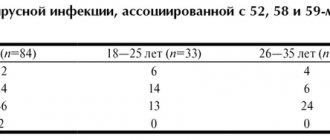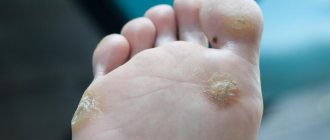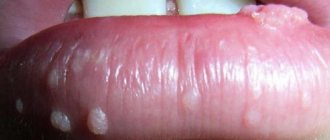+38 +38
- HomeStatsArticlesOn gynecology
Nowadays, patients are often diagnosed with human papillomavirus (HPV), and after this the eternal question begins to arise, what to do?
To begin with, I would like to talk a little about it: the definition of the human papillomavirus.
To summarize, HPV infection can be in the following forms:
- Latency is defined as the persistence of papillomavirus in the basal layer of the epithelium. In this case, the virus is in episomal form (the viral DNA molecule is not embedded in the cell DNA molecule) and does not lead to pathological changes in cells. The latent course of the infection is characterized by the absence of clinical manifestations, colposcopic, cytological and histological norms. The presence of HPV infection is determined by DNA methods (PCR).
- Dysplasia (neoplasia) develops when the DNA of the virus is integrated (introduced) into the cell genome. With neoplasia, changes occur in the structure of epithelial cells. Most often, lesions are localized in the transition zone of the cervix. At the junction of stratified squamous and columnar epithelium, basal cells, sensitive to viral infection, are in close proximity to the surface layers, which facilitates contact with the virus during infection. HPV infection is confirmed by histological examination and colposcopy.
- In the case of invasive tumor carcinoma, the virus in the cell exists in an integrated form. In this case, altered, “atypical” cells are identified, indicating the malignancy of the process. The most common location is the transition zone of the cervix. Identified by colposcopic and histological examination.
A productive infection involves clinical manifestations of infection (papillomas, warts, condylomas). In this case, the virus, which exists in episomal form, is copied in infected cells. At the same time, there is an increased proliferation of cells in the basal layer of the epithelium, which leads to the progression of infection and the appearance of vegetations (growths). Clinically, productive infection is defined as warts or papillomas. The virus is detected by PCR. Histological examination reveals the phenomena of hyperkeratosis (increased keratinization, i.e. cell aging).
How does HPV infection manifest?
The main symptom of infection caused by the human papillomavirus is the formation of so-called genital warts.
Externally, genital warts are similar to ordinary warts. They can be small in size (from a few millimeters to a centimeter), pinkish or flesh-colored, and have a smooth or slightly bumpy surface.
Most often, genital warts form in the area of the external genitalia.
In women, genital warts can occur near the clitoris, on the labia minora and majora, in the vagina and on the cervix. In case of irritation of condylomas located close to the entrance to the vagina, itching and minor bleeding may occur during sexual intercourse.
In men, genital warts form on the penis and scrotum.
Condylomas can also form in the anus, in the urethra, or in any other place on the skin (skin of the neck, armpits). Several condylomas located nearby can merge into one large “wart”.
Generally, genital warts are painless. In some cases, mild itching and discomfort are felt in the area of condylomas.
HPV type 68
Skrgej
January 8, 2020
HPV type 68 was discovered 6 years ago. 3-4 warts appeared on the pubic area but then went away on their own, there was inflammation of the prostate and clear discharge for a long time (about a year), then everything gradually went away. Now PCR has shown again the presence of HPV 68 - Abs. Value -6, Dygen test is relative. — 11.1. At the moment, I am worried about the frequent exacerbation of prostatitis with decreased immunity. donated prostate secretions - leukocytes in 15 places to 30 The urologist says prostatitis is not associated with HPV, but is this so? Could it be that due to a constant inflammatory process, the urethra, bladder and prostate are damaged by this HPV? For a month, I studied everything there is on the Internet about this type of HPV on Russian and foreign sites and realized that no one really writes anything specific. Everyone says that with HPV, genital warts appear and they are removed, and if there is nothing, then there is no need to treat anything. I began to study it myself on the Internet on Russian and foreign sites. Here are the facts that I was able to find: 1) this type of HPV is poorly studied, is not very common in Europe and Russia, there are controversial facts about its oncogenicity (in various studies in Korea and Europe they write about isolated cases of HPV being found in the studies they conducted - within 1 -2% of all patients they studied). It is more common in Asia (Korea China) where it is detected in up to 5% of cases. In these study groups, HPV 68 was more often found in either patients with normal cytology or LSIL. There are isolated cases of carcinoma. 2) On the Russian Internet they write that, according to statistics, it is not as terrible as 18 and 16, which cause up to 70% of oncology. But this statistics is not informative - it simply says that these are the most common types of all oncogenic types, but this does not say anything about the degree of oncogenicity, but only about their prevalence among the population, right? On many Russian-language sites they write information that contradicts foreign sites - for example, by searching for HPV 68 in Yandex and studying the first 20 sites, I found out that 68 is very aggressive and very dangerous, and that there is a 70% chance of cervical cancer, which scared me so much that I can’t sleep peacefully for a month . It’s unclear who to trust! I am interested in the following: if the virus does not eliminate itself (they say that in 90% of cases it goes away on its own, but this is not a fact, most likely it just falls asleep, as I understand it), and if a woman after 30 has it in her body, WHAT IS THE PROBABILITY of abnormalities in the cervix in the future? That is, what is the chance that the virus will not cause problems? 50/50 or 70/30 or 90/10? Are there statistics on this topic? In just one place I found that with highly oncogenic HPV, the risk is 10% for dysplasia and within 1% for oncology, and even then it is not clear which gynecologist writes. It seems that in Russia they do not conduct full-fledged research, they do not study HPV as they do abroad. Does anyone have any statistics on this type? Are there any studies by Russian scientists on this topic and specifically on HPV types? (Naturally I am interested in HPV68). Are there specific symptoms for this type of HPV? I understand from reading Russian-language websites that it may not cause genital warts, but at the same time everything can be covered with flat, barely noticeable papillomas, and inside the urethra and bladder.. both in men and women. There is a risk of damage to the intestines and the entire genitourinary system. Who can say something more specific about the symptoms of type 68? Today I have been taking isoprinosine for a month after the removal of two papillomas on the scrotum to exclude a relapse as prescribed by an immunologist. Is it possible to immediately give injections of Allokin alfa after isoprinosine? Many doctors recommend and write that it has a great effect on oncogenic HPV. Panavir suppositories were also recommended. What do you advise? 5. When and what should I take after taking isoprinosine to see the dynamics?
Age:
38
Chronic diseases:
Prostatitis
The question is closed
Diagnosis of HPV?
To confirm the diagnosis of human papillomavirus infection, the PCR (polymerase chain reaction) method is used, which allows you to determine the DNA of the virus and determine exactly what type of virus a person is infected with.
In modern diagnostic laboratories, the type of virus, its quantity (viral load) and integration of the virus into the genome are determined. At the beginning of the article, information is provided that shows that the most dangerous HPV are high-oncogenic risk (HOR). In addition to the type of virus, the definition and its quantity are important. Treatment tactics depend on this. Unfortunately, the integration of the virus into the cell genome is not determined in our laboratories. This analysis is important in the early diagnosis of cervical epithelial dysplasia and non-invasive carcinoma.
It is very important that everyone understands that even if a PCR test reveals oncogenic forms of HPV in you, this does not mean that you already have cervical cancer or that you will inevitably get it in the near future, since not in all cases does HPV lead to to the development of cancer. It can take years from the moment of infection to the appearance of precancer.
In order to determine whether HPV has caused changes in the cells of the cervix and whether there is a risk of developing cancer, it is necessary to undergo a thorough gynecological examination, which necessarily includes:
- Colposcopy (examination of the cervix with a device that resembles a microscope and allows viewing under a magnification of 8 to 20 times).
- Cytological smear (PAP test), which is used to determine dysplastic changes in the cells of the cervix.
- Bacterioscopic examination of vaginal discharge. Often, HPV infection is combined with other sexually transmitted infections (in approximately 20% of cases), so additional examination may be necessary to determine chlamydia, mycoplasmosis, ureaplasmosis and trichomoniasis.
- Targeted biopsy is the removal of a piece of cervical tissue in cases of dysplasia or suspected malignant tumor of the cervix.
Myths about human papillomavirus (HPV)
The most common myths about human papillomavirus.
Myth 1 The HPV virus is common in African countries where the standard of living is low.
Human papillomavirus does not choose a continent or country.
It can infect any sexually active person in any part of the world. Today it is one of the most common pathogens transmitted through sexual contact or skin and mucous membranes. Even four out of five sexually active people become infected with this virus at least once in their lives. Myth 2 Only women are infected with HPV.
Any sexually active person can be infected with the HPV virus, even if they have only one partner.
Men face the same or higher risk of acquiring HPV and can become carriers and spreaders of the virus. During their lifetime, 4 out of 5 sexually active people will become infected with HPV at some point in their lives. Although the body of most infected people clears the virus on its own, the possibility of reinfection with this or another virus remains for life. If the human body does not remove the virus and it remains in the cells, the risk of developing the cervix, vagina, vulva, anus, penis, mouth, pharynx, larynx, and root of the tongue increases. Long-term low-risk HPV infection causes warts on these organs. Myth 3 Among my friends, I am the only one who has been diagnosed with this virus, so I don't think it is that common.
The vast majority are unaware of the virus.
It is not surprising that they may simply not know about their disease. Research shows that one in four women of reproductive age is infected with HPV, and even four out of five sexually active people will become infected with HPV during their lifetime. This virus can disappear from the body on its own, so a woman is sometimes unaware of a possible HPV infection if she has not been tested at this stage of life, especially since a temporary infection does not cause any symptoms of the disease. Men are generally not tested for HPV infection, although they can carry and spread the virus. Myth 4 HPV is only transmitted through casual sex or multiple sexual encounters.
It is true that the transmission of STIs is higher when there are multiple sexual partners, but the belief that infection only affects those with many casual relationships is inherently false. In fact, HPV also threatens those who are involved with one long-term partner. Even if your sexual partner is your first and only sexual partner, you can still become infected with HPV if he or she had contact with someone infected with HPV in the past and became a carrier. Myth 5
If I was diagnosed with HPV, then my partner was unfaithful to me.
A diagnosis of HPV does not mean your partner is unfaithful.
This myth causes anger, confusion, anxiety and fear. The virus lurks in a latent, asymptomatic state in the patient's body for weeks, months and years. Then they talk about a chronic infection. Obvious symptoms sometimes take time (months, years). If you are confirmed to have the virus with one regular partner, this means that your friend may have had sex with someone who was infected with HPV at some point in their life before you. Myth 6 All types of HPV cause cancer.
Not true.
HPVs are classified into high- and low-risk types (genotypes). Cancer is caused by high-risk HPV genotypes. The International Agency for Research on Cancer has confirmed that papillomavirus type 14 has a high risk of developing cancer. The oncogenicity of other viruses is being studied. The highest oncogenic risk is for types 16 and 18 of HPV. Low levels of HPV, for example 6 and 11, do not cause cancer. Myth 7 Genital warts will immediately become cancer.
Warts localized in the genital area are benign in almost all cases.
There’s a reason why these types of HPV are called “low-risk.” Low-risk HPV types may cause temporary changes in cervical cytology; however, these changes are not cancerous. If you find cytological changes, you should make sure that there are no high-risk human papillomaviruses, which are the biggest factor in the development of cervical cancer. Myth 8 If I get HPV, I will feel some signs of infection.
Most people infected with HPV do not feel any symptoms. A temporary infection is unlikely to cause warts or cancer. In nine out of ten people who are infected, the infection clears up within two years. Although they do not feel any symptoms, they can infect their sexual partners. Myth 9 An "abnormal" cytological change in the cervix is cancer.
Cytological changes in the cervix are caused not only by HPV infections.
These cellular changes can occur due to microdamage, bacterial infection, a low-risk HPV type, or even inadequate tissue collection and evaluation studies. For these reasons, repeating the test several months later will usually not detect cytological changes. The doctor will most likely recommend a colposcopy, take a tissue biopsy, may suggest assessing the type of HPV infection for high risk, and only then will be able to say Are these changes truly precancerous and should they be treated at this time, or can they be observed until they may go away on their own? In all cases, women should take responsibility for their own health and be checked at intervals recommended by health care professionals. Myth 10 If I was diagnosed with HPV, the disease will recur again and again.
In some cases, if the HPV infection persists in the body for a long time and the person's immune system is weak, warts or precancerous genital changes may appear several times during a given period of life.
The good news is that most people do not have an infection after two years. The bad news is that one in five sexually active people can become infected with the same HPV virus every year. The human immune system is weakened by chronic diseases, certain medications, injury, stress, anemia, various infections and other factors. We cannot determine how long the HPV infection will remain in the body. Each individual case is individual. Myth 11 For older women, cytological examination of the cervix is not required.
Cancerous changes take time.
This may take a year, ten years or more. If HPV infection occurs in old age, the virus is released from the body more slowly, and the longer it remains in the human body, the higher the risk of precancerous changes and cancer. At older ages, latent infection may reactivate. The decision not to get tested can be fatal: one in four women diagnosed with cervical cancer are 65 years of age or older. More than 40% of deaths from cervical cancer also occur in women of this age. Myth 12 If I cure my warts, I will no longer pose a threat to my partner.
Removing warts does not mean the HPV infection is completely gone. Visible warts are usually treated with medications or surgically removed.
The risk of wart transmission after HPV treatment is likely to be reduced by destroying the cells in which the virus was found. However, the virus can also remain in surrounding cells that do not show any changes visible to the eye, so transmission of infection is possible. Myth 13 I don't have to worry about HPV because my partner doesn't have genital warts.
The absence of warts on the genitals does not necessarily mean that your partner does not have HPV.
Often the HPV virus is physically invisible, so you cannot tell by sight whether your partner has the infection. Myth 14 If a woman is diagnosed with cervical lesions, her partner should be tested for HPV infection.
It is now generally accepted that if female cervical lesions are detected, there is no need to identify sexual transmission of HPV infection. The partner likely had an HPV infection for some time in his life, although no signs of infection were diagnosed or vice versa. Of course, if a woman is diagnosed with genital warts, her partner is also advised to get tested because most people do not even notice very small warts in their genital areas.
Myth 15 I have no risk of contracting HPV because I use condoms.
When using condoms, the likelihood of contracting HPV is reduced, but using a condom can sometimes only help “get rid of existing HPV infections faster.” Proper and timely use of condoms can prevent diseases that are transmitted through body fluids (gonorrhea, trichomoniasis, etc.), in while human papillomavirus, herpes infection is spread by contact of skin and mucous membranes.
The condom does not cover the entire perineal membrane, so the vulva, anal, perianal areas, base of the penis, and scrotum remain open to contact and transmission of HPV. Myth 16 I don’t have sex, so I can’t get HPV.
HPV viruses can be transmitted during any sexual relationship, as well as through direct contact with skin or mucous membranes.
HPV infection can be transmitted to a newborn from the mother. Myth 17 HPV can be cured.
Cancer caused by warts or precancerous lesions can be cured, but there is no vaccine or drug for all types of the virus. Each body has the ability to destroy this virus on its own.
The spontaneous disappearance of the virus depends on the strength of the body's immune system, the aggressiveness and quantity of the virus. It is also true that a person's immune system can suppress the aggressiveness of the virus so that it does not compromise health until it disappears completely. Myth 18 HPV infection can cause infertility.
HPV infection does not affect women's fertility. If a woman is pregnant and infected with HPV, she may develop warts or precancerous lesions, but regular checkups help ensure timely treatment. However, women can pass HPV infection to their newborns during childbirth.
HPV treatment
Since a complete cure for human papillomavirus infection is currently impossible to achieve (along with this, spontaneous, spontaneous recovery is often observed), the manifestations of HPV are treated, and not the presence of the virus in the body. Moreover, the effectiveness of various treatment methods is 50-70%, and in a quarter of cases the disease manifests itself again several months after the end of treatment. The question of the appropriateness of treatment for each patient is decided by the doctor individually. In this case, it is necessary to avoid factors that reduce immunity (hypothermia, severe emotional stress, chronic fatigue, vitamin deficiency). There are studies that suggest the preventative effect of retinoids (beta-carotene and vitamin A), vitamin C and micronutrients such as folate against diseases caused by HPV.
Among the methods of treating manifestations of HPV infection (genital warts and papillomas), the most commonly used are:
- Destructive methods
are local treatment aimed at removing condylomas.
There are physical ( cryodestruction, laser therapy, diathermocoagulation, electrosurgical excision
) and chemical (
trichloroacetic acid, feresol, solcoderm
) destructive methods, as well as
surgical removal of condylomas
.
Cytotoxic drugs
-
podophyllin, podophyllotoxin (
condylin ), 5-fluorouracil
. Women of childbearing age are advised to use reliable contraception or avoid sexual activity during treatment. - Interferons (
Laferon, Laferobion, Alfarekin, Reaferon, Viferon )
are most often used to treat HPV infection . They are a family of proteins that are produced by cells of the immune system in response to stimulation by viruses. A separate drug is Alokin-alpha, which stimulates the production of its own interferon and activates cellular immunity. - Specific antiviral drugs ( cidofovir, panavir, alpirazine
). The well-known antiviral drug acyclovir (Zovirax) has no effect on HPV. Of the local (vaginal) drugs, Epigen intimate spray and Betadine have an antiviral effect.










